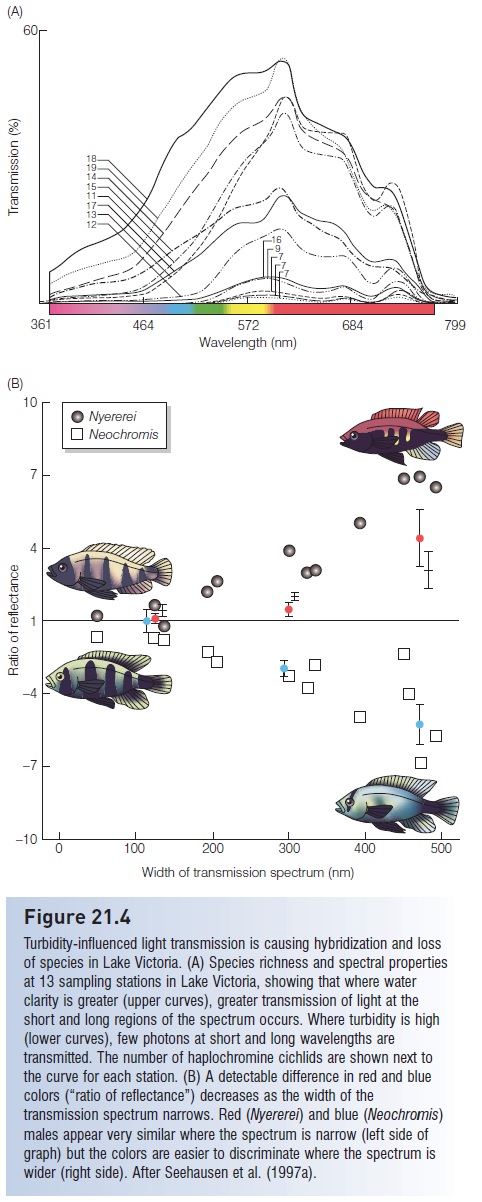Chapter: The Diversity of Fishes: Biology, Evolution, and Ecology: Individuals, populations, and assemblages
Hybridization - Diversity of Fishes
Hybridization
An individual contains combinations of genes that have evolved together over millions of years. Different species contain different gene combinations, which means that a hybrid individual brings together genes that have not undergone such fine-tuned co-evolution. The result is that hybrid individuals are typically aberrant in some aspect of their biology, which can be expressed as faster growth or more vigorous mating behavior, a phenomenon referred to as hybrid vigor or heterosis. However, most natural hybrids are inefficient reproductively, ecologically, biochemically, physiologically, or behaviorally. They are therefore likely to be reproductive failures because of sterility, relatively infertility, or an inability to find or attract mates, or will be ecological failures because they will be outcompeted for resources or be more prone to capture by predators than are individuals from single species matings. Natural selection will obviously favor spawning individuals that avoid mating with members of other species. This separation of species during mating is accomplished via species isolating mechanisms, which are usually anatomical or behavioral traits that keep individuals of different species from breeding with one another. Species isolating mechanisms include genitalia that do not match up correctly, as in internally fertilized livebearers or elasmobranchs, or they may result from incompatibility between sperm and eggs, or differences in courtship patterns, timing, or location of spawning. Any inappropriate cues given by one or the other member of a spawning pair can lead to termination of the spawning act.
Hybridization in fishes often occurs when one species experiences a substantial reduction in abundance. When a rare species breeds in the same place and time as an abundant species, interspecific matings are more likely (Hubbs 1955). Hybridization is also common in disturbed habitats where the preferred spawning sites of one species are lacking, forcing them to spawn in another habitat and hence with another species. When exotic but related species are introduced into a region, isolating mechanisms between the introduced and the established species may not have evolved and hybridization may occur.
Among fishes, instances of hybridization are most common in freshwater fishes and less well documented among marine species (e.g., Schwartz 1981, 2001; Epifanio & Nielsen 2000; Scribner et al. 2000). Freshwater families among which natural hybrids are often found include the minnows (Cyprinidae), suckers (Catostomidae), salmons and trouts (Salmonidae), sunfishes and black basses (Centrarchidae), and darters (Percidae). Artifi cial hybrids produced in aquaculture are also common, as in the sunshine bass (a cross between a male Striped Bass, Morone saxatilis, and a female White Bass, M. chrysops), the splake (a cross between a Lake Trout,Salvelinus namaycush, and a Brook Trout, S. fontinalis), and the tiger muskellunge (a cross between a Northern Pike, Esox lucius, and a Muskellunge, E. masquinongy). Hybrid marine fishes are much less common. The most common marine examples occur in the reef fish families of butterfl yfishes (Chaetodontidae) and angelfishes (Pomacanthidae), although distinctive, complex color patterns and popularity among aquarium keepers make hybrids in these families more likely to be detected (Pyle & Randall 1994). Other marine groups known to hybridize include anguillid eels, serranid seabasses, acanthurid surgeonfishes, pleuronectiform flatfishes, and balistid triggerfishes (Bostrom et al. 2002; Randall et al. 2002; Garrett 2005; Albert et al. 2006).
The disproportionate numbers of hybrids among freshwater species could reflect the greater degree of physical disturbance and of species introductions in freshwater habitats. Examples of disturbance-induced hybridization include cichlids in Lake Victoria, where females cannot distinguish among males of different species because turbidity impairs light transmission at long and short wavelengths of light (Fig. 21.4). In the Pecos River of New Mexico and Texas, the Critically Endangered Pecos River Pupfish,Cyprinodon pecosensis, is restricted to two sinkhole habitats. Its habitat has been invaded by a widespread, introduced species, the Sheepshead Minnow, C. variegatus. Hybrids between Sheepshead Minnow and Pecos River Pupfish have completely replaced the endemic pupfish along 500 km of the Pecos River (Echelle & Echelle 1997). In Europe, where habitat disruption is all too prevalent, several endemic cyprinids are impacted by introduced species. In southern Italy, Italian Bleak, Alburnus albidus (designated Vulnerable by the International Union for the Conservation of Nature, IUCN) hybridizes with an introduced cyprinid, Leuciscus cephalus cabeda; another endemic cyprinid, Chondrostoma toxostoma arrigonis, hybridizes with introduced C. polylepis polylepis in Spain (Crivelli 1995).

Hybridization is usually a dead end for the individuals produced by the hybrid cross, although successful new species may be produced via hybridization, as in the case of the parthenogenetic, unisexual live-bearers of the genus Poecilia in Mexico (see Gender roles in fishes).
Related Topics